Baculoviridae is a family of viruses. Arthropods, lepidoptera, hymenoptera, diptera, and decapoda serve as natural hosts. There are currently 66 species in this family, divided among 4 genera.

The beet armyworm or small mottled willow moth is one of the best-known agricultural pest insects. It is also known as the asparagus fern caterpillar. It is native to Asia, but has been introduced worldwide and is now found almost anywhere its many host crops are grown. The voracious larvae are the main culprits. In the British Isles, where it is an introduced species and not known to breed, the adult moth is known as the small mottled willow moth.

The African armyworm, also called okalombo, kommandowurm, or nutgrass armyworm, is a moth of the family Noctuidae. The larvae often exhibit marching behavior when traveling to feeding sites, leading to the common name "armyworm". The caterpillars exhibit density-dependent polyphenism where larvae raised in isolation are green, while those raised in groups are black. These phases are termed solitaria and gregaria, respectively. Gregaria caterpillars are considered very deleterious pests, capable of destroying entire crops in a matter of weeks. The larvae feed on all types of grasses, early stages of cereal crops, sugarcane, and occasionally on coconut. The solitaria caterpillars are less active and undergo much slower development. The species is commonly found in Africa, but can also be seen in Yemen, some Pacific islands, and parts of Australia. African armyworm outbreaks tend to be devastating for farmland and pasture in these areas, with the highest-density outbreaks occurring during the rainy season after periods of prolonged drought. During the long dry seasons ("off-season"), the population densities are very low and no outbreaks are seen.
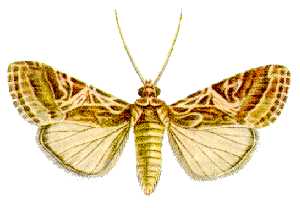
Spodoptera litura, otherwise known as the tobacco cutworm or cotton leafworm, is a nocturnal moth in the Noctuidae family. S. litura is a serious polyphagous pest in Asia, Oceania, and the Indian subcontinent that was first described by Johan Christian Fabricius in 1775. Its common names reference two of the most frequent host plants of the moth. In total, 87 species of host plants that are parasitized by S. litura are of economic importance. The species parasitize the plants through the larvae's vigorous eating patterns, oftentimes leaving the leaves completely destroyed. The moth's effects are quite disastrous, destroying economically important agricultural crops and decreasing yield in some plants completely. Their potential impact on the many different cultivated crops, and subsequently the local agricultural economy, has led to serious efforts to control the pests.

Spodoptera cilium, known variously as dark mottled willow, lawn caterpillar and grasslawn armyworm, is a noctuid moth found throughout much of sub-Saharan Africa and western, southern, and south-east Asia and several countries in southern and eastern Europe. It is a migrant to northern Europe and has been recorded at least nine times in the United Kingdom.

Spodoptera littoralis, also referred to as the African cotton leafworm or Egyptian cotton leafworm or Mediterranean Brocade, is a species of moth in the family Noctuidae. S. littoralis is found widely in Africa, Mediterranean Europe and Middle Eastern countries. It is a highly polyphagous organism that is a pest of many cultivated plants and crops. As a result, this species was assigned the label of A2 quarantine pest by the EPPO and was cautioned as a highly invasive species in the United States. The devastating impacts caused by these pests have led to the development of both biological and chemical control methods. This moth is often confused with Spodoptera litura.
Ascoviridae is a family of double strand DNA viruses that infect primarily invertebrates, mainly noctuids and spodoptera species; it contains two genera, Ascovirus, which contains three species, and Toursvirus with a single species Diadromus pulchellus toursvirus. The type species of Ascovirus is Spodoptera frugiperda ascovirus 1a, which infects the army worm.
The Caradrinini are a mid-sized tribe of moths in the Hadeninae subfamily.

Spodoptera is a genus of moths of the family Noctuidae first described by Achille Guenée in 1852. Many are known as pest insects. The larvae are sometimes called armyworms. The roughly 30 species are distributed across six continents.
Iflaviridae is a family of positive sense RNA viruses insect-infecting viruses. Some of the insects commonly infected by iflaviruses include aphids, leafhoppers, flies, bees, ants, silkworms and wasps. The name "Ifla" is derived from the name "Infectious flacherie virus", for the type species. There is only one genus (Iflavirus) and 14 species in this family, including the type species Infectious flacherie virus.
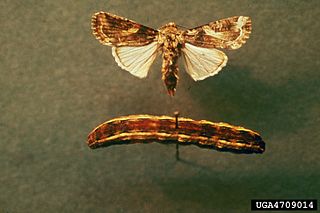
Spodoptera ornithogalli is a moth of the family Noctuidae found in Guadeloupe, Marie-Galante, Saint Kitts, Dominica, Cuba, Dominican Republic, Mexico, Guatemala, Costa Rica. In North America, it is found from California to Florida plus the eastern states, west to Kansas, and in south-eastern Canada from Nova Scotia to Ontario. In South America, it is found in Argentina, Brazil, Colombia, French Guiana, Paraguay, Peru, and Venezuela. This particular species is known to be the American representative of the sister species Spodoptera littoralis as two species have very similar forms. However, S. ornithogalli is known to have much darker color body with sharper markings.
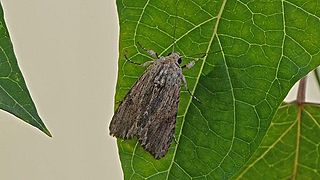
The southern armyworm is a moth that is known to be a pest. They are one of the most important defoliators in the tropical and subtropical regions of the western hemisphere that feed heavily on plants while they are young, often resulting in skeleton leaves on their food plants. They are also heavy feeders on tomato in Florida. There is a lot of development in producing pesticides against the S. eridania, specifically a neem-based pesticide that can result in smaller and prolonged development. The wingspan is 33–38 mm. Adults are on wing year-round. The larvae feed on various weeds but prefer Amaranthus species and Phytolacca americana.

Spodoptera mauritia, the lawn armyworm or paddy swarming caterpillar, is a moth of the family Noctuidae. The species was first described by Jean Baptiste Boisduval in 1833. Able to eat many types of food, it is a major pest throughout the world.
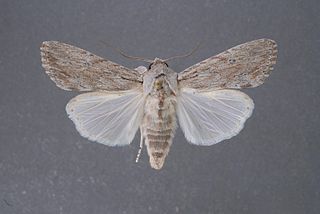
Spodoptera albula is a moth of the family Noctuidae found from the southern United States, south to South America.
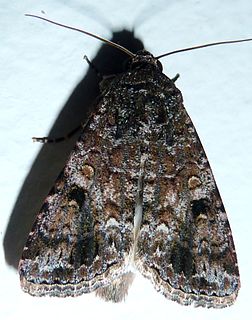
Spodoptera triturata, the lawn worm, is an Afrotropical moth of the family Noctuidae found in Sierra Leone, the Democratic Republic of Congo, Kenya, and South Africa.
Spodoptera picta, the lily caterpillar, is a moth of the family Noctuidae. It was described by Félix Édouard Guérin-Méneville in 1838. It is found in India, Sri Lanka, Australia and Japan.
Alphabaculovirus is a genus of viruses in the family Baculoviridae. Its natural hosts include a wide range of invertebrates, among them winged insects, Lepidopterans, Hymenopterans, Dipterans, and decapods. There are currently 32 species in the genus, including the type species Autographa californica multiple nucleopolyhedrovirus.

Spodoptera androgea, the androgea armyworm moth, is a species of cutworm or dart moth in the family Noctuidae. It is found in North America.













